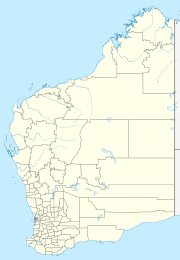Piesseville, Western Australia facts for kids
Quick facts for kids PiessevilleWestern Australia |
|||||||||
|---|---|---|---|---|---|---|---|---|---|
| Established | 1903 | ||||||||
| Postcode(s) | 6315 | ||||||||
| Elevation | 303 m (994 ft) | ||||||||
| Location | |||||||||
| LGA(s) | Shire of Wagin | ||||||||
| State electorate(s) | Roe | ||||||||
| Federal Division(s) | O'Connor | ||||||||
|
|||||||||
Piesseville is a small town in the Wheatbelt region of Western Australia. This area is known for growing crops like wheat. Piesseville is about 211 kilometers (131 miles) south-east of Perth. It is located on the Great Southern Highway between the towns of Narrogin and Wagin. The town is also on the Great Southern Railway. In 2016, a survey showed that 59 people lived in Piesseville.
Contents
History of Piesseville
Early Days and First Names
In the 1860s, some of the first settlers came to this area. They brought their sheep to graze on the land. The first official records of Piesseville began in 1889. This was when the Great Southern Railway opened. A small railway stop, called a "siding," was built here. It was named Buchanan River.
In 1897, the government decided to set aside land in this area. They planned to divide it into smaller blocks for people to buy and build on. By 1903, these blocks were measured, and the town was officially named Buchanan. People in the nearby town of Katanning were very interested in the new town. By 1904, a town hall, a school, and other buildings were ready.
Changing Names for a New Identity
The name Buchanan caused a problem. There was already another town called Buchanan in New South Wales. To avoid confusion, the town was renamed Barton in 1905. This new name honored Sir Edmund Barton, who was Australia's very first prime minister from 1901 to 1903.
However, the name Barton also caused issues later. In 1917, the Trans-Australian Railway was built. This railway crossed Australia. Along its path, in South Australia, there was another railway station named Barton. Because of this, the town needed another name change. In December 1918, it was renamed Piesse. This name honored two important local residents, Frederick Henry Piesse and Charles Austin Piesse.
Just five years later, the town's name changed one last time. In 1923, it became Piesseville, which is its name today. This means the town had four different names in just 20 years!
Piesseville Today
Today, Piesseville is mainly a farming area. People grow crops and raise animals here. The original town hall, built in 1904, is still standing. It is a reminder of the town's long history.


